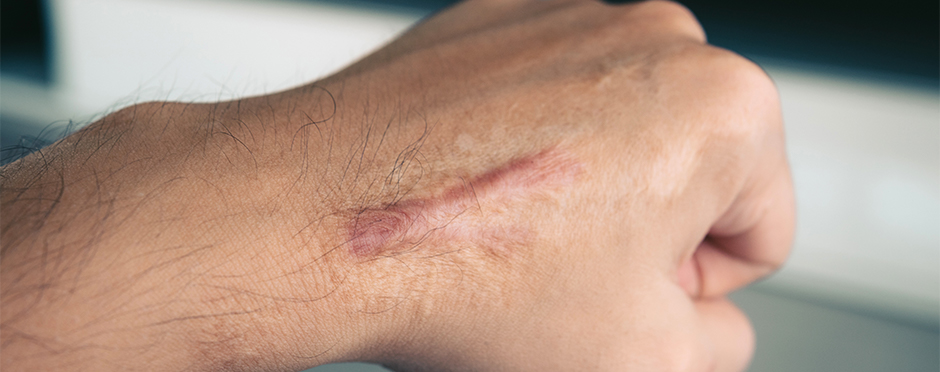
Why is this Scar Still Bothering Me? Understanding and Decreasing Scar Tissue
4 CommentsGreat news: your body has done some healing after an injury or surgery.
Not so great news: now you are looking at a scar.
The scar might be long or short. It might be raised, flat or indented. It could be a range of colors. It might be painful or sensitive. But, for whatever reason, it is still bothering you.
A scar is the body’s way of repairing the skin by laying down layers of collagen. After the wound is covered with an initial healed layer, techniques to improve the scar tissue can begin. The goal is to promote flexibility, normal sensation and prevent excessive build-up of scar tissue. The best time to address scar tissue is two weeks until six months after the scar is formed.
Sometimes a scar is simply the visual reminder of the injury. In other cases, addressing scar tissue can be an important part of the healing process. Scar tissue formation may affect the ability of skin or muscle to move or cause ongoing pain or hyper-sensitivity.
Common Problems Related to Scar Tissue:
- The scar may stick to the underlying tissue including the tendon or muscle.
- Hypersensitivity may make it difficult to tolerate textures or pressure to the area. For instance, a sleeve rubbing against a scar at the wrist could be unusually uncomfortable.
- Decreased movement or pain due to a scar that is thick. Scar tissue is less flexible than skin so it can restrict normal movement. For instance, following a mastectomy for breast cancer, a woman may have difficulty raising her arm due to scar tissue in her armpit.
Self-Care to Reduce Scar Formation:
- Hydration of tissue using unscented lotion, vitamin oil or cocoa butter.
- Self-massage to break up the scar tissue. Use one or two fingers with a firm pressure to gently move the scar tissue. Move across the scar or in circular motions.
- Remember skin care such as sunscreen to prevent burning to new sensitive skin and prevent further discoloration.
- Re-educate hypersensitive scars by rubbing the sensitive areas with a variety of textures starting with soft and moving toward more abrasive.
Addressing Scars as Part of Your Therapy Program
Occupational and physical therapists evaluate and treat scars as a part of providing complete care. The soft tissue of the hand can particularly be prone to scar formation. One common example is scar pain after a carpal tunnel release surgery. The scar at the palm of the hand may be sensitive or painful for gripping or pushing up from a chair. Another example would be following a tendon repair, the formation of scar tissue may attach to the tendon and prevent a smooth glide for bending the finger.
How Can an Occupational Therapist Reduce a Scar?
- Soft tissue mobilization: a skilled practitioner can use their hands to stretch and move the scar tissue to improve flexibility and keep it from attaching to underlying tissues.
- Ultrasound: a modality that uses sound waves to heat up the tissue. This can then be followed by soft tissue mobilization.
- Occupational and physical therapists can use tools such as Graston or ASTM® to further mobilize the layers to skin, muscle and scar tissue.
- Hand therapists have additional products that can be applied to help soften scar tissue overnight.
- Provide exercises that keep joints and tendons moving.
- Special taping or compression can also help minimize scar formation.
Maybe you already plan to see an occupational therapist or a physical therapist as part of your post-surgery or injury care. Great! Mention your concerns regarding your scar and they can include it into your plan of care. Or, maybe you have tried on your own to manage your scar and need a little more help to get the results you want – regardless of your circumstance you can contact your local Athletico for more information about healing scar tissue.
The Athletico blog is an educational resource written by Athletico employees. Athletico bloggers are licensed professionals who abide by the code of ethics outlined by their respective professional associations. The content published in blog posts represents the opinion of the individual author based on their expertise and experience. The content provided in this blog is for informational purposes only, does not constitute medical advice and should not be relied on for making personal health decisions.
References:
Deshaies, Lisa. “Burns.” The Fundamentals of Hand Therapy: Clinical Reasoning and Treatment
Guidelines for Common Diagnoses for the Upper Extremity, Mosby Elsevier, 2009, pp. 389–403.
“Scar Management.” Handcare.org, 2016, www.assh.org/handcare/procedures-and-treatment/scarmanagement

4 Comments
Simran Ahuja
Thanks for writing this blog!!! I have been annoyed with the scars on my knees and it makes me conscious when i wear shorts. This is the reason why i’m looking for a scar management treatment
Rabbitzan
It’s been a year or more and I still have a scar. Not only that but I ended up scratching recently and it started to bleed. Am I stuck with this scar now? It’s the only scar that I have I just think it’s odd to see sores on it and bleeding. I am gunna see my doctor about it when they let me.
Pearl
Please l need help for my scar problems
Charis
I had this scar when I was young didn’t see the need to get rid of it buh now I always feel ashamed when people ask me how I got a scar in the middle of my Thumb finger and my other finger